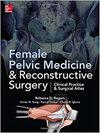Complications After Vaginal Vault Suspension Versus Minimally Invasive Sacrocolpopexy in Women With Elevated Body Mass Index: A Retrospective Cohort Study Using Data From the National Surgical Quality Improvement Program Database
IF 1.4
4区 医学
Q3 OBSTETRICS & GYNECOLOGY
Female Pelvic Medicine and Reconstructive Surgery
Pub Date : 2022-02-15
DOI:10.1097/SPV.0000000000001146
引用次数: 1
Abstract
Supplemental digital content is available in the text. Importance Overweight and obese women represent a growing share of pelvic floor reconstruction surgeons’ practices. Determining perioperative risk specific to this population is essential to inform decision making regarding operative approach in this population. Objective The aim of the study was to compare surgical complications among overweight and obese women undergoing apical compartment prolapse surgery by either minimally invasive abdominal or vaginal approach. Study Design The American College of Surgeons National Surgical Quality Improvement Database was used to identify overweight and obese patients (body mass index ≥ 25) undergoing either minimally invasive sacrocolpopexy (MISC) or vaginal vault suspension (VVS) in the form of a sacrospinous vault fixation or uterosacral ligament fixation for pelvic organ prolapse from 2012 to 2019. Odds ratios for surgical complications, readmission, and reoperation were estimated using multivariable logistic regression. Results Of 8,990 eligible patients, 5,851 underwent a VVS and 3,139 patients underwent MISC. There was a greater odds of any complication in the first 30 days following VVS (n = 608 [10.4%]) compared with MISC (n = 247 [7.9%]; odds ratio, 1.27; 95% confidence interval, 1.08–1.48) on multivariable analysis. Urinary tract infections (UTIs) were the most common complication and were more likely following VVS (112 (3.6%) versus 350 (6.0%), P < 0.001). When UTIs were excluded, there was no difference in complications between approaches (1.00; 95% CI, 0.82–1.22). There were no statistically significant odds of readmission, reoperation, or serious complications between approaches. Conclusions Vaginal vault suspension may be associated with a higher odds of any complication compared with MISC in overweight and obese women, but the rate of serious complications, readmission, and reoperation are low, and approaches were comparable when considering complications other than UTI.体重指数升高妇女阴道拱顶悬吊术与微创骶管切除术后并发症的比较:一项使用国家手术质量改进计划数据库数据的回顾性队列研究
文本中提供了补充数字内容。重要性超重和肥胖女性在盆底重建外科医生的实践中所占比例越来越大。确定该人群的围手术期风险对于该人群的手术方法决策至关重要。目的本研究的目的是比较超重和肥胖女性接受微创腹部或阴道入路根尖节室脱垂手术的并发症。研究设计2012年至2019年,美国外科医生学会国家外科质量改进数据库用于确定超重和肥胖患者(体重指数≥25),这些患者接受了微创骶管切除术(MISC)或阴道穹窿悬吊术(VVS),形式为骶棘穹窿固定术或子宫骶骨韧带固定术,用于治疗盆腔器官脱垂。使用多变量逻辑回归估计手术并发症、再次入院和再次手术的比值比。结果在8990例符合条件的患者中,5851例接受了VVS,3139例接受了MISC。在多变量分析中,VVS后的前30天出现任何并发症的几率(n=608[10.4%])高于MISC(n=247[7.9%];比值比,1.27;95%置信区间,1.08-1.48)。尿路感染(UTI)是最常见的并发症,在VVS后更容易发生(112(3.6%)对350(6.0%),P<0.001)。当排除UTI时,两种方法之间的并发症没有差异(1.00;95%CI,0.82-1.22)。两种方法间再次入院、再次手术或严重并发症的几率没有统计学意义。结论在超重和肥胖女性中,与MISC相比,阴道拱顶悬吊术可能与任何并发症的发生率更高有关,但严重并发症、再次入院和再次手术的发生率较低,在考虑UTI以外的并发症时,方法是可比的。
本文章由计算机程序翻译,如有差异,请以英文原文为准。
求助全文
约1分钟内获得全文
求助全文
来源期刊

Female Pelvic Medicine and Reconstructive Surgery
OBSTETRICS & GYNECOLOGY-
CiteScore
2.10
自引率
12.50%
发文量
228
期刊介绍:
Female Pelvic Medicine & Reconstructive Surgery, official journal of the American Urogynecologic Society, is a peer-reviewed, multidisciplinary journal dedicated to specialists, physicians and allied health professionals concerned with prevention, diagnosis and treatment of female pelvic floor disorders. The journal publishes original clinical research, basic science research, education, scientific advances, case reports, scientific reviews, editorials and letters to the editor.
 求助内容:
求助内容: 应助结果提醒方式:
应助结果提醒方式:


